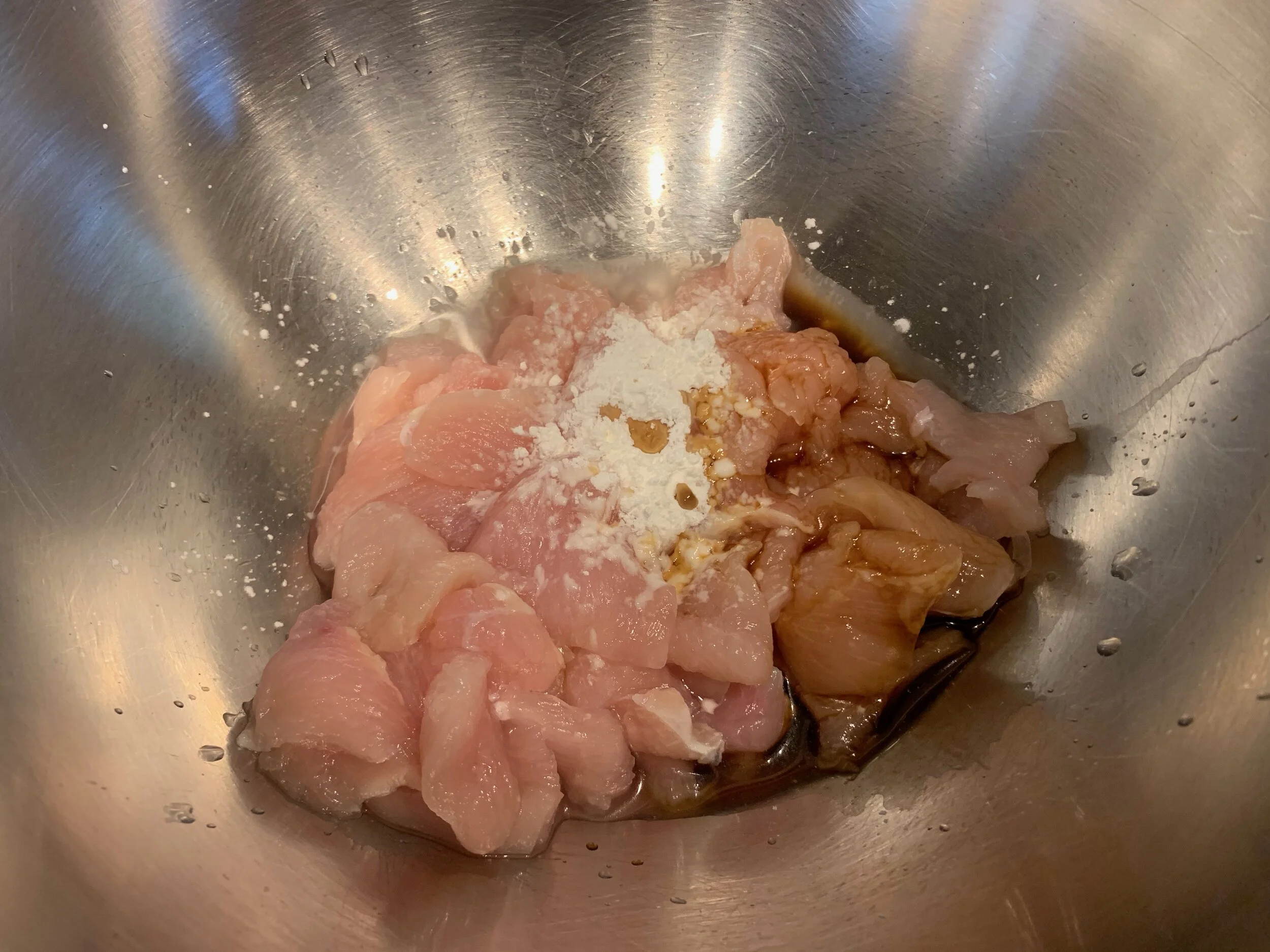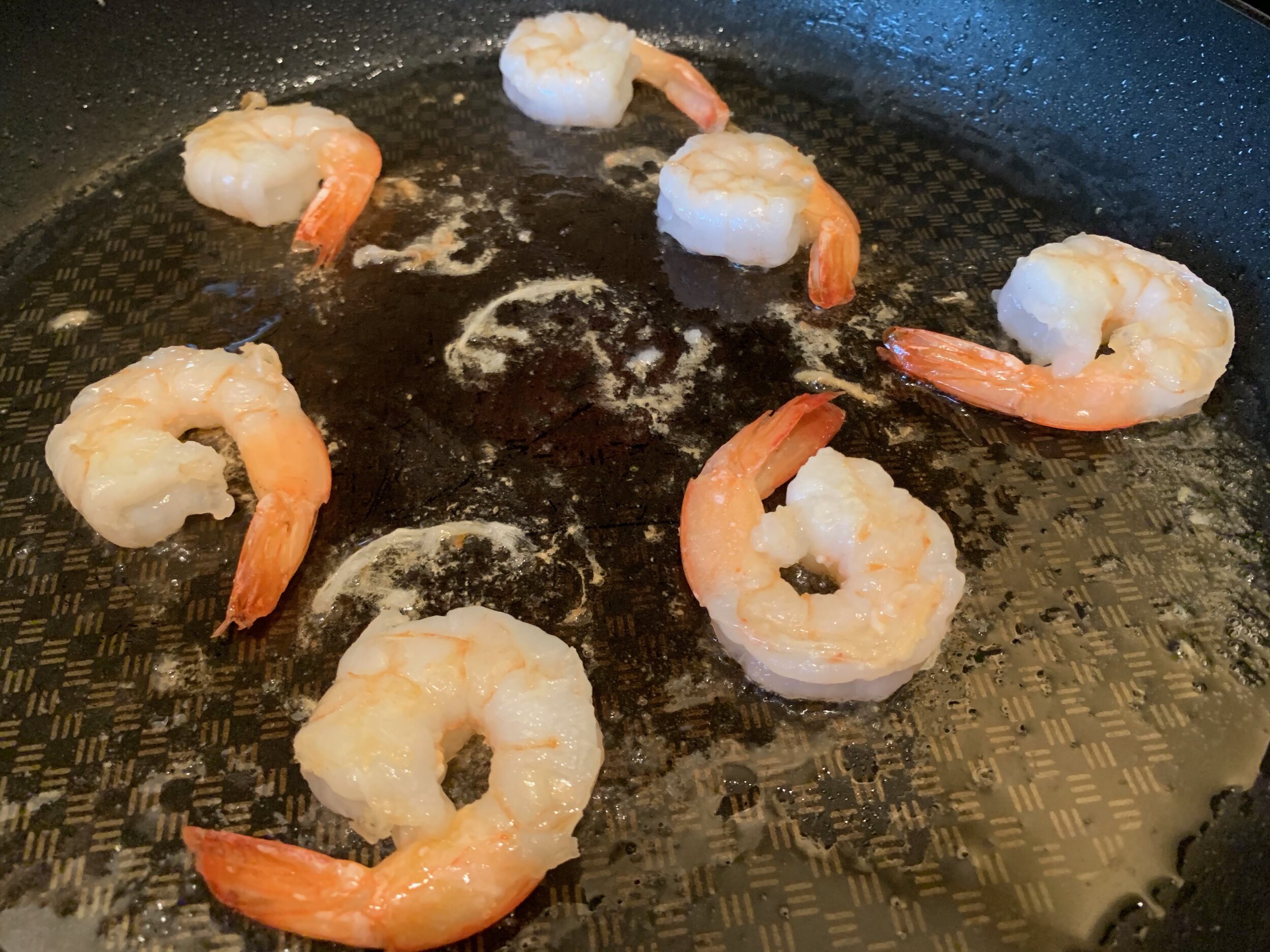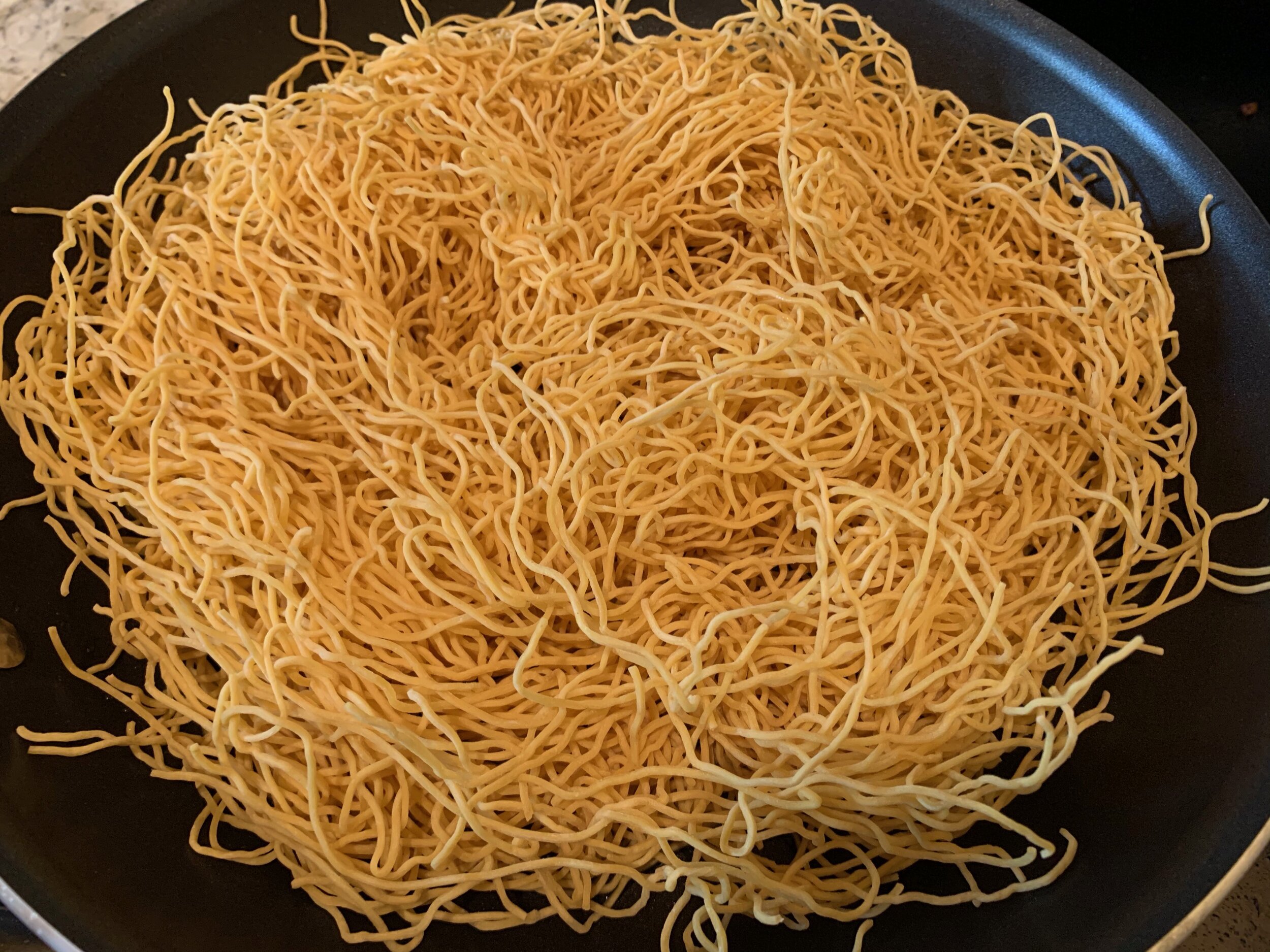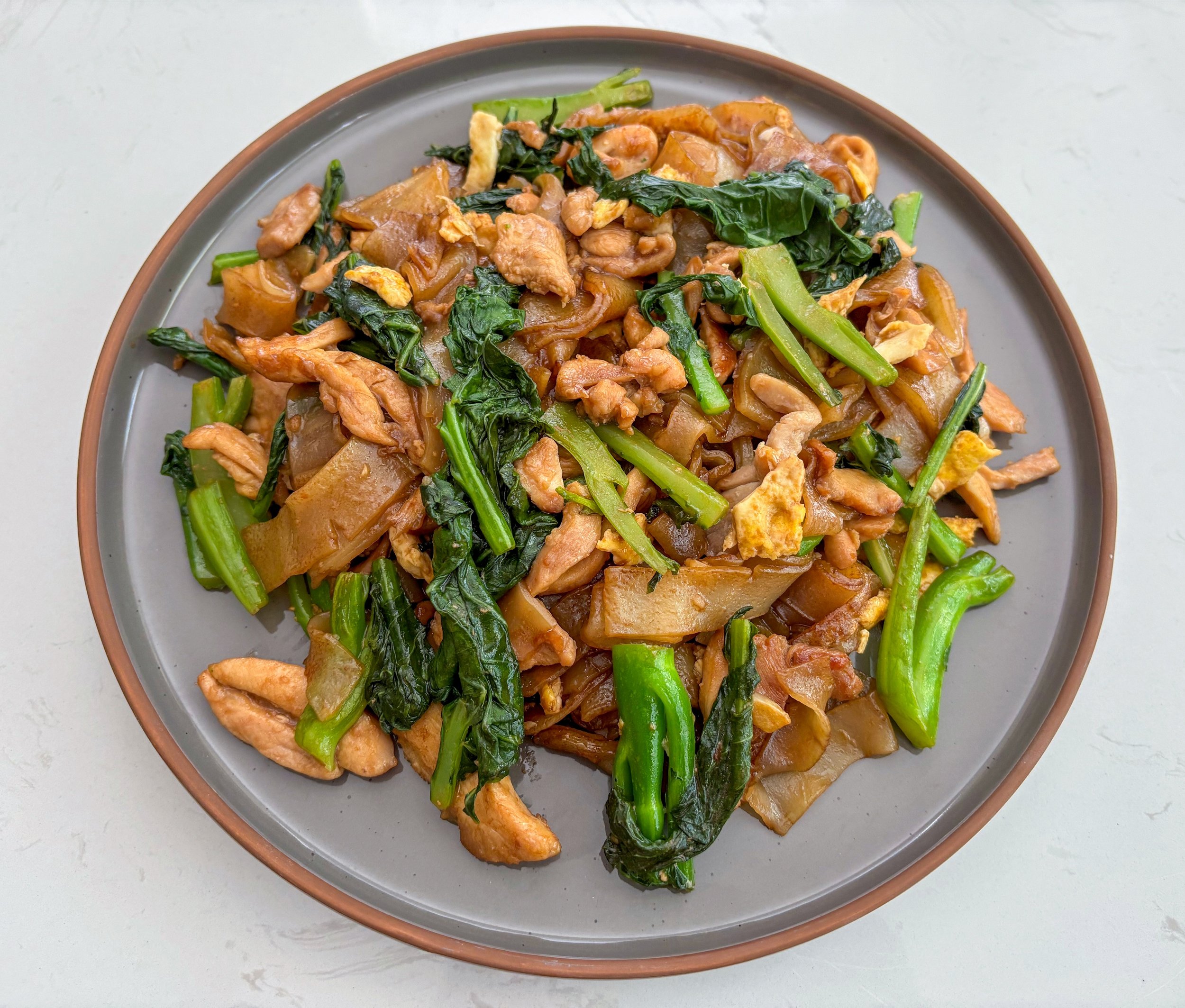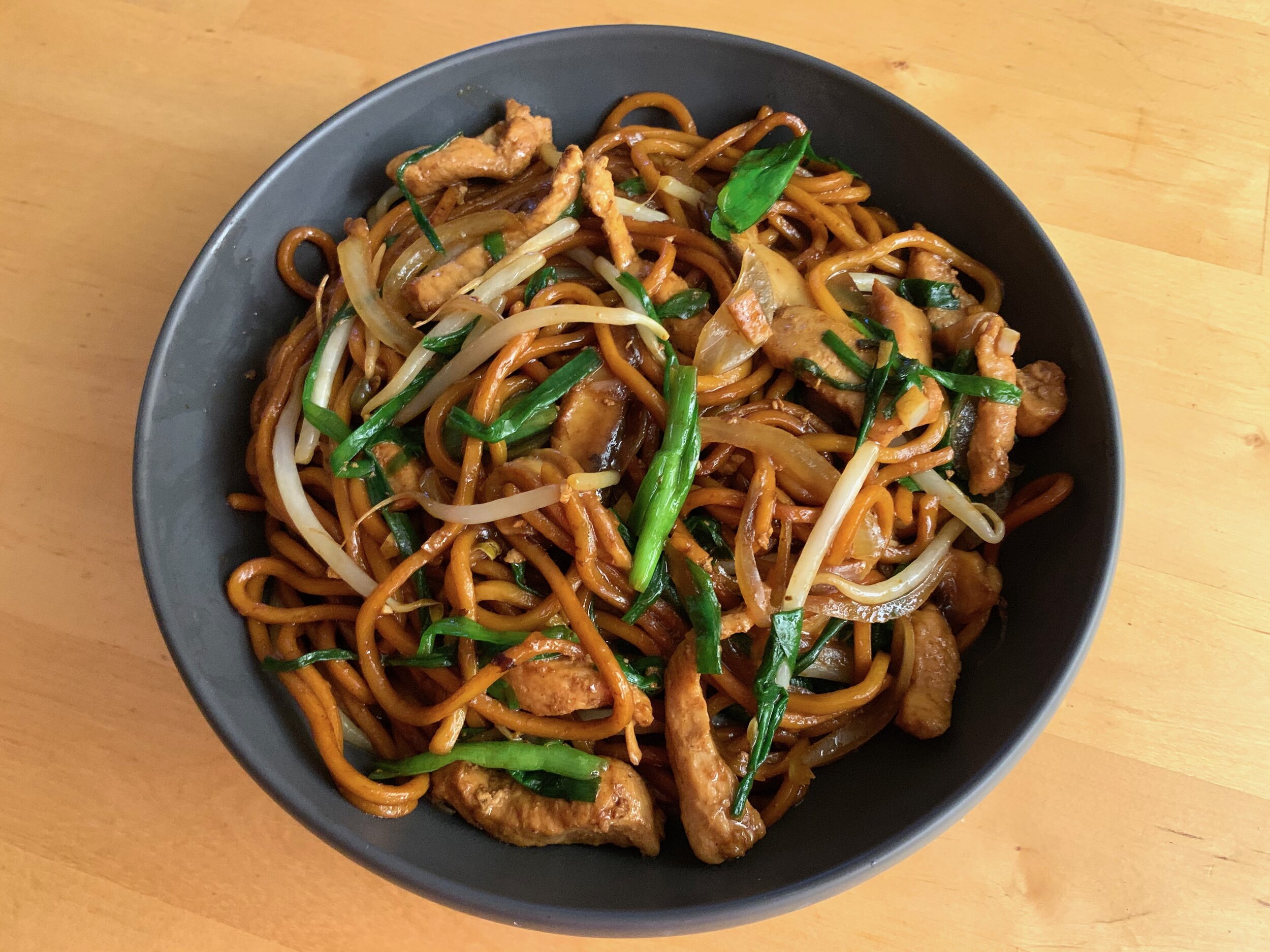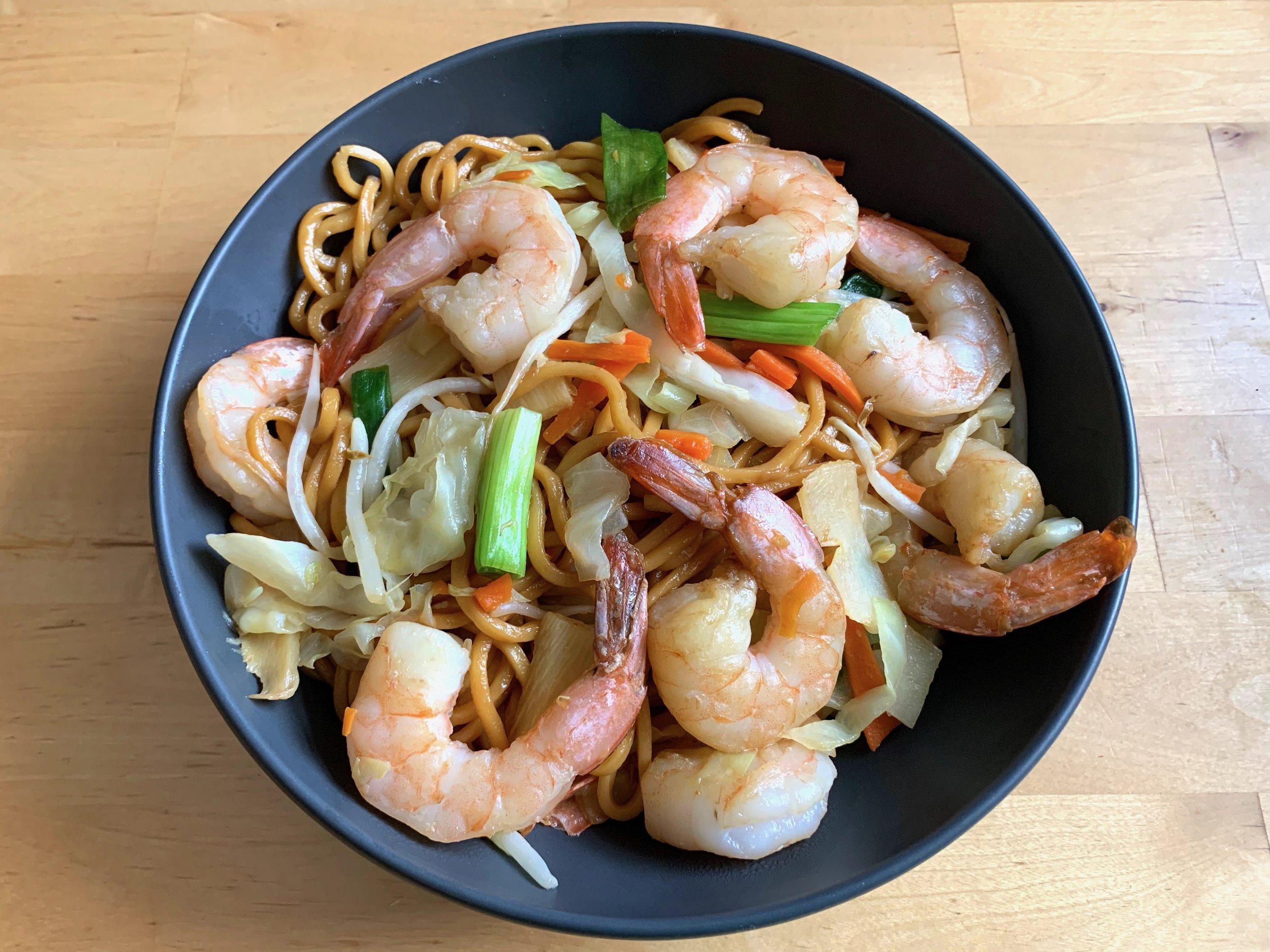Crispy Pan-Fried Noodles

兩面黄 (Liang Mian Huang)
Crispy pan-fried noodles are a showstopping dish at Cantonese and Hong Kong-style restaurants. A crunchy and tender nest of noodles topped with a stir-fry of meat, seafood, and vegetables, it is a perfect centerpiece to a banquet table. While this dish has many components, we can prepare each of them separately, making pan-fried noodles a manageable project for a home cook!
Ingredients
For the Noodles
12 oz thin Hong Kong-style egg noodles
Vegetable oil
For the Chicken
1 chicken breast
½ tsp baking soda
1 tsp soy sauce
1 tsp cornstarch
For the Stir-Fry
¼ lb shrimp
6 shiitake mushrooms, sliced
1 cup snow peas, trimmed
1 cup mung bean sprouts
1 carrot, thinly sliced
3 oz bok choy, quartered
For the Sauce
1 cup chicken stock
2 cloves garlic, minced
2 tsp soy sauce
¼ tsp white pepper
2 tsp oyster sauce
1 tsp sesame oil
2 tsp cornstarch
Let’s start by preparing our chicken for the stir-fry by cutting the chicken breast against the grain into thin slices about ¼ inch thick. To get the ultra-tender chicken breast you find in Chinese restaurant-style stir-fries, we’re going to use a bit of soda. Baking soda increases the pH and denatures the proteins on the surface, preventing them from further polymerizing when heated. For small pieces of meat with a high surface area to volume ratio, this surface effect will noticeably change the texture of the entire piece of meat, resulting in a tender and juicy texture.
Since acid-base reactions occur on a relatively fast timescale, a brief treatment is sufficient. Stir about 1 teaspoon of cornstarch into the chicken pieces. Let stand for 10 minutes, then thoroughly rinse the baking soda off with cold water. Be sure to wash off all of the baking soda, otherwise the chicken will taste a bit bitter. After the chicken has been cleaned, marinade the pieces by mixing them with 1 teaspoon soy sauce and 1 teaspoon cornstarch. Marinate the chicken for at least 10 minutes.
While the chicken is marinating, we can prepare our vegetables. The carrot and mushrooms should be sliced, and the snow peas need to be trimmed of their strings. If you prefer bok choy presented in this dish restaurant-style, cut them into quarters along the axis of symmetry, then thoroughly wash the pieces. If you can’t be bothered, this dish works just fine with separated bok choy leaves.
The stir-fry which will top our noodles contains many components—vegetables, chicken, shrimp, and a sauce. We will be preparing each of these components separately, ensuring that each element is perfectly cooked. When you’re ready to cook the vegetables, heat about 1 teaspoon vegetable oil in a skillet over medium-high heat. When the oil is up to temperature, add the sliced carrots, mushrooms, and bok choy to the skillet. Cook the vegetables for 5 minutes, covered and tossing occasionally, until the bok choy is tender.
While the vegetables are cooking, we can put together the sauce. In a saucepan over medium heat, combine the chicken stock, minced garlic, 2 teaspoons soy sauce, white pepper, oyster sauce, and 1 teaspoon sesame oil. Stir these ingredients well and bring to a boil. In a separate bowl, mix together 2 teaspoons cornstarch with a bit of cold water to form a cornstarch slurry, which will thicken the sauce. When the sauce comes to a boil, pour the slurry into the saucepan. Stir well and let the sauce thicken, then remove the sauce from the heat and set aside.
Returning to the vegetables, add the mung bean sprouts and snow peas to the skillet. The sprouts and peas will cook quickly, so toss the vegetables together and cook for just 1 minute or so. When the vegetables are done, remove from the heat and place in a large heatproof bowl.
Next up, chicken. Wipe the skillet clean, then then add another teaspoon vegetable oil to the skillet and place it over medium heat. Once the skillet comes up to temperature, add the marinated chicken pieces in a single layer. For this dish, we do not want the chicken to color in the pan. We can accomplish this by keeping the chicken moving in the pan as it cooks. Cook the chicken breast for about 1 minute per side, or until it is just cooked through. Then remove the cooked chicken to the same holding bowl as the vegetables.
Finally, onto the shrimp. Add a bit more vegetable oil to the skillet if necessary, then fry the shrimp for about 30 seconds per side, or until they have turned pink and are just cooked through. Depending on the size of your shrimp, you may have to adjust the cook time. Add the cooked shrimp to the holding bowl—we will reheat the stir-fry ingredients just before serving. With all of the stir-fry components done, we can turn our attention to the crispy noodles.
There are many varieties of Chinese egg noodles, but for this recipe, we will use Hong Kong-style thin egg noodles, sometimes labeled as “Hong Kong pan-fried noodles.” [1] These noodles do not have to be boiled before frying, which saves us a great deal of time and labor. Place the noodles in a large bowl, and run your fingers gently through them, breaking up any clumps or knots. Some restaurants prepare this dish by deep-frying the entire cake of noodles. This method is difficult to do at home, and in my opinion also results in a worse dish—the noodles are uniformly crunchy, and the web of noodles will retain a lot of the oil, making the final product greasy. I prefer the more traditional pan-frying method, which produces contrasting layers of crunchy and tender noodles, and very little grease!
Heat 1 tablespoon vegetable oil in a clean nonstick pan over medium heat. When the oil is up to temperature, add the noodles to the pan. Using a pair of chopsticks, swirl the noodles about the pan until the cake of noodles is of a uniform thickness. Then add ¼ cup of water to the pan, which will create a bit of steam and help cook the noodles in the center of the cake. Monitor the bottom of the noodle cake, using a spatula to peek underneath and make sure it isn’t burning, and that your burner and pan do not have any hot spots. [2] Cook the noodles for about 5 minutes, or until the bottom of the noodle cake is golden brown and crispy.
Now, it’s time to flip the noodle cake. If you feel very bold, you can go ahead and flip the noodle cake in the air, catching it back in the pan. If you’re not feeling up to that, however, there’s a much easier way of flipping the noodles. Simply slide the noodle cake onto a large plate. Then place a second plate upside down on the first. By inverting the two plates, we will flip the noodles cooked side up. Add another tablespoon of oil to the pan, then return the noodle cake to the pan, un-fried side down. Fry the noodle cake for 5 more minutes, again checking the bottom for scorching, until both sides are crisp and the noodles are completely warmed through. Remove the fried noodle cake to your serving dish.
The last step is to combine all of the stir-fry ingredients and warm them through. In a big skillet over high heat, mix together the sauce, cooked vegetables, chicken, and shrimp. Toss continuously and cook for 2-3 minutes, or until all the ingredients are just warmed through. We don’t want to overcook the chicken or shrimp! When the stir-fry is ready, ladle the mixture over the noodle cake. Then serve the dish immediately, before the noodles get soggy!
Substitutions
There are many variations on the stir-fried noodle topping, so feel free to experiment here! You can substitute the chicken with pork or beef, go all-in on a seafood version featuring shrimp, squid, and scallops, or make an entirely vegetarian version. Other vegetables you can use in the stir-fry include oyster mushrooms, broccoli, water chestnuts, garlic chives, and scallions.
[1] Confused about which egg noodles to buy? Visit Serious Eats for a complete guide to Chinese egg noodles.
[2] If you do see hot spots, begin rotating the noodle cake every 30 seconds.
Recipe
Prep Time: 15 min Cook Time: 25 min Total Time: 40 min
Difficulty: 4/5
Heat Sources: 3 burners
Equipment: skillet, saucepan, nonstick pan
Servings: 6
Ingredients
For the Noodles
12 oz thin Hong Kong-style egg noodles
Vegetable oil
For the Chicken
1 chicken breast
½ tsp baking soda
1 tsp soy sauce
1 tsp cornstarch
For the Stir-Fry
¼ lb shrimp
6 shiitake mushrooms, sliced
1 cup snow peas, trimmed
1 cup mung bean sprouts
1 carrot, thinly sliced
3 oz bok choy, quartered
For the Sauce
1 cup chicken stock
2 cloves garlic, minced
2 tsp soy sauce
¼ tsp white pepper
2 tsp oyster sauce
1 tsp sesame oil
2 tsp cornstarch
Instructions
1. Cut the chicken breast against the grain into ¼ inch thick slices. Sprinkle over the baking soda and mix well. Let stand for 10 minutes, then rinse off the baking soda with cold water and drain the chicken pieces.
2. Mix the chicken pieces with 1 tsp soy sauce and 1 tsp cornstarch, then let marinate for 10 min or until ready to cook.
3. While the chicken marinates, trim and chop the vegetables. Heat 1 tsp vegetable oil in a skillet over medium-high heat. When the oil is up to temperature, add the carrots, mushrooms, and bok choy to the skillet. Cook, covered, for 5 minutes, or until the bok choy is tender.
4. While the vegetables cook, combine in a saucepan the chicken stock, minced garlic, 2 tsp soy sauce, white pepper, oyster sauce, and 1 tsp sesame oil. Stir well and bring to a boil. In a separate bowl, mix 2 tsp cornstarch with a bit of cold water to form a cornstarch slurry. When the sauce comes to a boil, pour the cornstarch slurry into the saucepan. Stir well and let the sauce thicken, then remove from the heat and set aside.
5. Add the mung bean sprouts and snow peas to the skillet with the other vegetables, and cook the vegetable mixture for 1 minute more, tossing to combine. Remove the vegetables from the heat and place in a large bowl.
6. Wipe the skillet dry, then add 1 tsp vegetable oil and place the skillet over medium heat. When the skillet comes up to temperature, add the marinated chicken in a single layer. We do not want to color the chicken, so keep it moving about the skillet. Cook for 1 minute per side, or until the chicken is just cooked through. Remove the cooked chicken to the same bowl as the vegetables.
7. Add a bit more vegetable oil to the empty skillet if necessary, then add the shrimp. Cook for 30 s per side, or until the shrimp have turned pink and are just cooked through. Remove to the same bowl as the chicken and vegetables.
8. Remove the noodles from the bag and place in a large bowl, gently separating any clumps of noodles with your fingers.
9. Heat 1 tbsp vegetable oil in a clean nonstick pan over medium heat. When the oil is up to temperature, add the noodles into the pan. Swirl the noodles about the pan so that the thickness of the noodle cake is uniform. Then add ¼ cup of water to the pan and cook for about 5 minutes, or until the bottom of the noodle cake is golden brown and crispy.
10. Slide the noodle cake out of the pan and onto a large plate. Place a second large plate over the first, then use the two plates to flip the noodle cake over.
11. Add an additional 1 tbsp vegetable oil to the pan, then slide the noodle cake back into the pan, un-fried side down. Fry for 5 more minutes, or until both sides are crisp. Remove the noodle cake to the serving dish.
12. Combine the sauce and the cooked vegetables and proteins a wide skillet over high heat. Toss the stir-fry ingredients together and cook for 2-3 minutes, or until warmed through.
13. Top the fried noodle cake with the stir-fry, then serve immediately.





